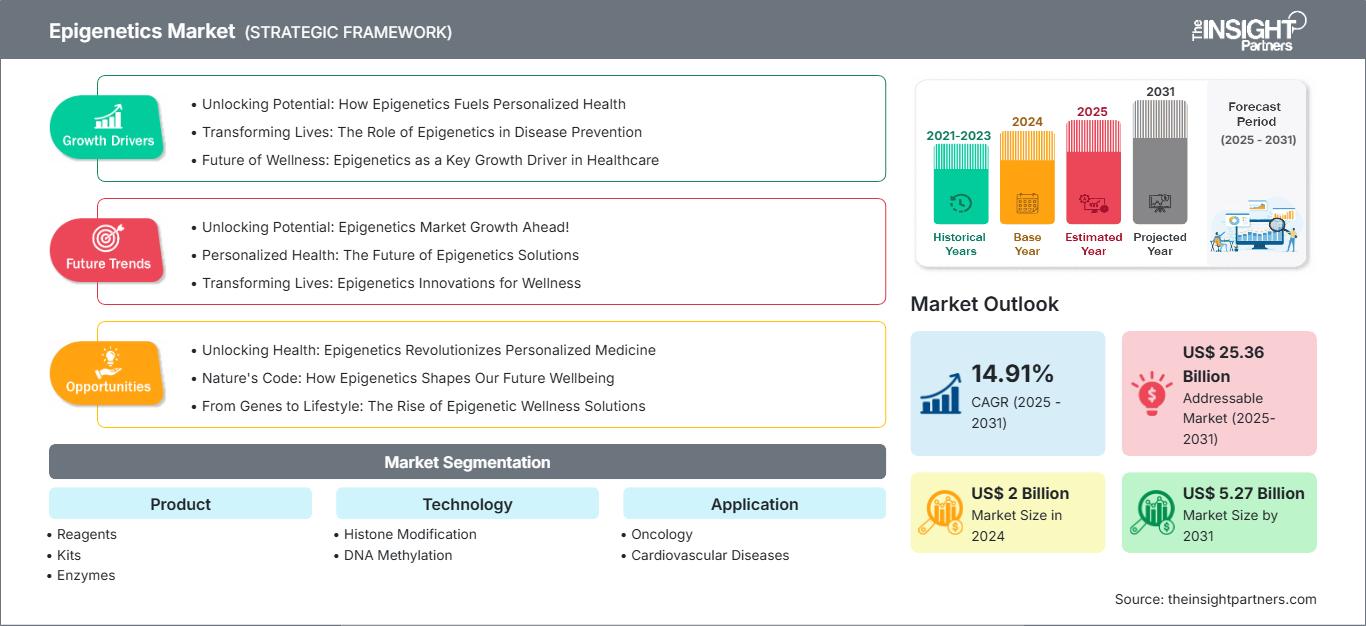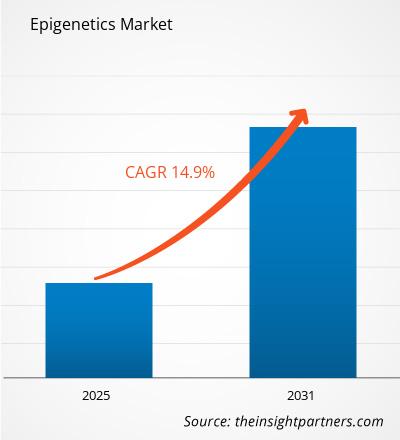من المتوقع أن يسجل سوق علم الوراثة الجينية معدل نمو سنوي مركب بنسبة 14.91٪ من عام 2025 إلى عام 2031، مع توسع حجم السوق من 2 مليار دولار أمريكي في عام 2024 إلى 5.27 مليار دولار أمريكي بحلول عام 2031.
يُصنّف التقرير حسب المنتج (الكواشف، الأدوات، الإنزيمات، الأجهزة والمواد الاستهلاكية، أدوات المعلوماتية الحيوية)، ويُحلل السوق بشكل أعمق بناءً على التقنيات (تعديل الهيستونات، مثيلة الحمض النووي). كما يُحلل السوق حسب التطبيق (علم الأورام، أمراض القلب والأوعية الدموية) والمستخدمين النهائيين في القطاع (المؤسسات الأكاديمية والبحثية، شركات التكنولوجيا الحيوية والأدوية، منظمات أبحاث العقود). ويُقدّم تحليلاً شاملاً على المستويات العالمية والإقليمية والقُطرية لكل من هذه القطاعات الرئيسية.
يتضمن التقرير حجم السوق والتوقعات لجميع القطاعات، مع عرض القيم بالدولار الأمريكي. كما يُقدّم إحصاءات رئيسية حول الوضع الحالي للسوق لدى أبرز الجهات الفاعلة، بالإضافة إلى رؤى حول اتجاهات السوق السائدة والفرص الناشئة.
غرض التقرير
يهدف تقرير "سوق علم الوراثة فوق الجينية" الصادر عن شركة "ذا إنسايت بارتنرز" إلى وصف المشهد الحالي والنمو المستقبلي، وأهم العوامل المحفزة، والتحديات، والفرص المتاحة. وسيوفر هذا التقرير رؤى ثاقبة لمختلف أصحاب المصلحة في قطاع الأعمال، مثل:
- مزودي/مصنعي التكنولوجيا: لفهم ديناميكيات السوق المتطورة ومعرفة فرص النمو المحتملة، وتمكينهم من اتخاذ قرارات استراتيجية مستنيرة.
- المستثمرون: لإجراء تحليل شامل للاتجاهات فيما يتعلق بمعدل نمو السوق، والتوقعات المالية للسوق، والفرص الموجودة عبر سلسلة القيمة.
- الهيئات التنظيمية: لتنظيم السياسات ومراقبة الأنشطة في السوق بهدف تقليل الانتهاكات والحفاظ على ثقة المستثمرين ودعم سلامة السوق واستقرارها.
تجزئة سوق علم الوراثة فوق الجينية
منتج
- الكواشف
- مجموعات
- الإنزيمات
- الأدوات والمواد الاستهلاكية
- أدوات المعلوماتية الحيوية
تكنولوجيا
- تعديل الهيستون
- مثيلة الحمض النووي
طلب
- علم الأورام
- أمراض القلب والأوعية الدموية
المستخدمون النهائيون
- المعاهد الأكاديمية والبحثية
- شركات التكنولوجيا الحيوية والأدوية
- منظمة أبحاث العقود
ستحصل على تخصيص لأي تقرير - مجانًا - بما في ذلك أجزاء من هذا التقرير، أو تحليل على مستوى الدولة، وحزمة بيانات Excel، بالإضافة إلى الاستفادة من العروض والخصومات الرائعة للشركات الناشئة والجامعات
سوق علم الوراثة فوق الجينية: رؤى استراتيجية

- احصل على أهم اتجاهات السوق الرئيسية لهذا التقرير.ستتضمن هذه العينة المجانية تحليل البيانات، بدءًا من اتجاهات السوق وحتى التقديرات والتوقعات.
عوامل نمو سوق علم الوراثة فوق الجينية
- إطلاق العنان للإمكانات: كيف يُغذّي علم الوراثة فوق الجينية الصحة الشخصية
- تغيير الحياة: دور علم الوراثة فوق الجينية في الوقاية من الأمراض
- مستقبل العافية: علم الوراثة فوق الجينية كمحرك رئيسي للنمو في مجال الرعاية الصحية
اتجاهات مستقبل سوق علم الوراثة فوق الجينية
- إطلاق العنان للإمكانات: نمو سوق علم الوراثة فوق الجينية في المستقبل!
- الصحة الشخصية: مستقبل حلول علم الوراثة فوق الجينية
- تغيير الحياة: ابتكارات علم الوراثة فوق الجينية من أجل العافية
فرص سوق علم الوراثة فوق الجينية
- إطلاق العنان للصحة: علم الوراثة فوق الجينية يُحدث ثورة في الطب الشخصي
- شفرة الطبيعة: كيف يؤثر علم الوراثة فوق الجينية على صحتنا المستقبلية
- من الجينات إلى نمط الحياة: صعود حلول العافية فوق الجينية
رؤى إقليمية حول سوق علم الوراثة فوق الجينية
قام محللو شركة "ذا إنسايت بارتنرز" بشرح شامل للاتجاهات والعوامل الإقليمية المؤثرة في سوق علم الوراثة فوق الجينية خلال فترة التوقعات. ويناقش هذا القسم أيضًا قطاعات سوق علم الوراثة فوق الجينية ومناطقها الجغرافية في أمريكا الشمالية، وأوروبا، وآسيا والمحيط الهادئ، والشرق الأوسط وأفريقيا، وأمريكا الجنوبية والوسطى.
نطاق تقرير سوق علم الوراثة فوق الجينية
| سمة التقرير | تفاصيل |
|---|---|
| حجم السوق في عام 2024 | 2 مليار دولار أمريكي |
| حجم السوق بحلول عام 2031 | 5.27 مليار دولار أمريكي |
| معدل النمو السنوي المركب العالمي (2025 - 2031) | 14.91% |
| البيانات التاريخية | 2021-2023 |
| فترة التنبؤ | 2025-2031 |
| القطاعات المغطاة | حسب المنتج
|
| المناطق والبلدان المغطاة | أمريكا الشمالية
|
| قادة السوق وملفات تعريف الشركات الرئيسية |
|
كثافة اللاعبين في سوق علم الوراثة فوق الجينية: فهم تأثيرها على ديناميكيات الأعمال
يشهد سوق علم الوراثة فوق الجينية نموًا سريعًا، مدفوعًا بتزايد طلب المستخدم النهائي نتيجةً لعوامل مثل تطور تفضيلات المستهلكين، والتقدم التكنولوجي، وزيادة الوعي بفوائد المنتج. ومع تزايد الطلب، تعمل الشركات على توسيع عروضها، والابتكار لتلبية احتياجات المستهلكين، والاستفادة من الاتجاهات الناشئة، مما يعزز نمو السوق.

- احصل على نظرة عامة على أهم اللاعبين الرئيسيين في سوق علم الوراثة فوق الجينية
نقاط البيع الرئيسية
- التغطية الشاملة: يغطي التقرير بشكل شامل تحليل المنتجات والخدمات والأنواع والمستخدمين النهائيين لسوق علم الوراثة فوق الجينية، مما يوفر مشهدًا شاملاً.
- تحليل الخبراء: تم تجميع التقرير على أساس الفهم العميق لخبراء الصناعة والمحللين.
- المعلومات الحديثة: يضمن التقرير أهمية الأعمال التجارية بسبب تغطيته للمعلومات الحديثة واتجاهات البيانات.
- خيارات التخصيص: يمكن تخصيص هذا التقرير لتلبية متطلبات العملاء المحددة وتلبية استراتيجيات العمل بشكل مناسب.
لذا، يُمكن لتقرير البحث حول سوق علم الوراثة فوق الجينية أن يُسهم في تمهيد الطريق لفهم سيناريوهات هذه الصناعة وآفاق نموها. ورغم وجود بعض المخاوف المُبررة، إلا أن فوائد هذا التقرير الإجمالية تفوق عيوبه.
- التحليل التاريخي (سنتان)، سنة الأساس، التوقعات (7 سنوات) مع معدل النمو السنوي المركب
- تحليل PEST و SWOT
- حجم السوق والقيمة / الحجم - عالمي، إقليمي، بلد
- الصناعة والمنافسة
- مجموعة بيانات إكسل
التقارير الحديثة
شهادات العملاء
سبب الشراء
- اتخاذ قرارات مدروسة
- فهم ديناميكيات السوق
- تحليل المنافسة
- رؤى العملاء
- توقعات السوق
- تخفيف المخاطر
- التخطيط الاستراتيجي
- مبررات الاستثمار
- تحديد الأسواق الناشئة
- تحسين استراتيجيات التسويق
- تعزيز الكفاءة التشغيلية
- مواكبة التوجهات التنظيمية




















 احصل على عينة مجانية ل - سوق علم الوراثة فوق الجينية
احصل على عينة مجانية ل - سوق علم الوراثة فوق الجينية